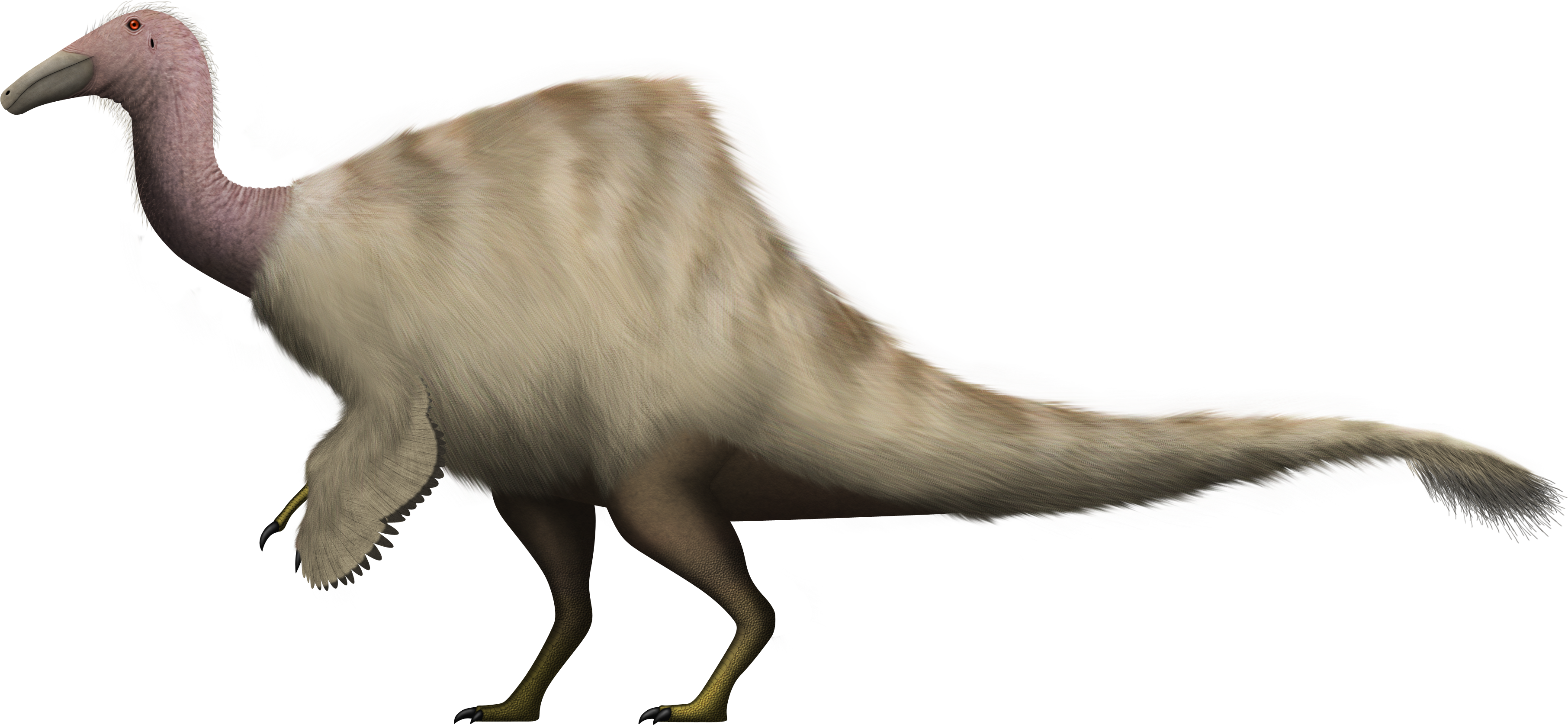ShopDreamUp AI ArtDreamUp
Deviation Actions
Suggested Deviants
Suggested Collections
You Might Like…
Featured in Groups
coelurosaurdeinocheirusdinosaurdinosauriadinosaurspalaeoartpalaeontographytheropodtheropodatheropodsfeathereddinosaurcoelurosauriamirificusornithomimosauriacoelurosaursbirdlikedinosaurbirdlikedinosaurscoelurosauriantheropoddinosaurdeinocheirus2014deinocheirusmirificusdeinocheirusnewlookdeinocheirus2015deinocheirus2016deinocheirus_mirificusfeathered
Description
Another take on Deinocheirus. This time, its partially feathered, which is more likely than full feathering IMO. It has some sparse fuzz on it's neck if you look closely.
This one also has its tail fan formed by EBFFs (extremely broad filamentous feathers) rather than retrices (pennaceous feathers on bird wings and tails). Turns out that fused end-of-tail caudals don't necessarily hint at retrices outside of pennaraptorans, as shown be the therizinosaurid Beipiaosaurus.
Also see the more floofy version with tail retrices.
___________________________
Deinocheirus mirificus - A half-century enigma finally solved...
Temporal range: Late Cretaceous, Maastrichtian, ~70-65.5 Ma
Length: Around ~10-13 metres
Probable mass: Around ~6+ tonnes
Etymology: Unusual horrible hand
Deinocheirus was one of the largest likely-feathered dinosaurs known. This Tyrannosaurus-sized ornithomimosaurian possessed a hump and a head that looked somewhat like a hadrosaur's. The hump is supported by tall neural spines up to ~8.5 times the height of the centrum, which served to support the torso from the hips via an intricate system of ligaments that served like an asymmetrical cable-stayed bridge.
This dinosaur was discovered in 1965, when a pair of arms with scapulacoracoids (Zpal MgD-I/6 or MPC-D 100/18) were discovered in the Gobi Desert. For several decades, this was all that's known from Deinocheirus.
Two new specimens (MPC-D 100/127 & the juvenile specimen MPC-D 100/128) described in 2014 provided almost all the skeletal information on Deinocheirus and solved the mystery surrounding it. Over 1400 gastroliths, each ranging ~8-87 millimetres in diameter, have been found in its stomach cavity. This, along with fish remains and its ecomorphological features, suggests that Deinocheirus was a megaomnivore. The deep buccal cavity in its lower jaws suggests a massive tongue which would have created suction for ingesting it's food.
Robust hindlimbs with posteroventrally tilted wide hips, femora longer than the tibiae, and massive feet indicate that Deinocheirus was not a fast runner. The relatively small diameter of its sclerotic ring suggests that Deinocheirus was diurnal, mainly active during daylight. Its lower jaw was deep compared to the relatively slender upper jaw in lateral view. Pits on the anterior surface of its skull suggests a rhamphotheca, or a bird-like beak, in life.
Deinocheirus was quite pneumatic, comparable to the pneumaticity level of a sauropod. It has at least two fused caudals at the end of its tail, suggesting a pygostyle or feather tail fan. It is currently the tallest known theropod at more than 5+ metres tall at the head.
This one also has its tail fan formed by EBFFs (extremely broad filamentous feathers) rather than retrices (pennaceous feathers on bird wings and tails). Turns out that fused end-of-tail caudals don't necessarily hint at retrices outside of pennaraptorans, as shown be the therizinosaurid Beipiaosaurus.
Also see the more floofy version with tail retrices.
___________________________
Deinocheirus mirificus - A half-century enigma finally solved...
Temporal range: Late Cretaceous, Maastrichtian, ~70-65.5 Ma
Length: Around ~10-13 metres
Probable mass: Around ~6+ tonnes
Etymology: Unusual horrible hand
Deinocheirus was one of the largest likely-feathered dinosaurs known. This Tyrannosaurus-sized ornithomimosaurian possessed a hump and a head that looked somewhat like a hadrosaur's. The hump is supported by tall neural spines up to ~8.5 times the height of the centrum, which served to support the torso from the hips via an intricate system of ligaments that served like an asymmetrical cable-stayed bridge.
This dinosaur was discovered in 1965, when a pair of arms with scapulacoracoids (Zpal MgD-I/6 or MPC-D 100/18) were discovered in the Gobi Desert. For several decades, this was all that's known from Deinocheirus.
Two new specimens (MPC-D 100/127 & the juvenile specimen MPC-D 100/128) described in 2014 provided almost all the skeletal information on Deinocheirus and solved the mystery surrounding it. Over 1400 gastroliths, each ranging ~8-87 millimetres in diameter, have been found in its stomach cavity. This, along with fish remains and its ecomorphological features, suggests that Deinocheirus was a megaomnivore. The deep buccal cavity in its lower jaws suggests a massive tongue which would have created suction for ingesting it's food.
Robust hindlimbs with posteroventrally tilted wide hips, femora longer than the tibiae, and massive feet indicate that Deinocheirus was not a fast runner. The relatively small diameter of its sclerotic ring suggests that Deinocheirus was diurnal, mainly active during daylight. Its lower jaw was deep compared to the relatively slender upper jaw in lateral view. Pits on the anterior surface of its skull suggests a rhamphotheca, or a bird-like beak, in life.
Deinocheirus was quite pneumatic, comparable to the pneumaticity level of a sauropod. It has at least two fused caudals at the end of its tail, suggesting a pygostyle or feather tail fan. It is currently the tallest known theropod at more than 5+ metres tall at the head.
Image size
3624x1675px 5.27 MB
© 2016 - 2024 SpinoInWonderland
Comments12
Join the community to add your comment. Already a deviant? Log In
Hello! I was wondering if i may use this in a youtube video i am making, (we will give you 100% credit of course) and we are not monetizing our videos.
Youtube channel is; The Expeditioner's Discovery Guild, if you were wondering
www.youtube.com/channel/UCAaqN…
Youtube channel is; The Expeditioner's Discovery Guild, if you were wondering
www.youtube.com/channel/UCAaqN…



































